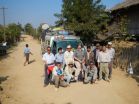(Press-News.org) BOULDER, Colo – Researchers at the University of Waterloo in Canada have directly entangled three photons in the most technologically useful state for the first time, thanks in part to superfast, super-efficient single-photon detectors developed by the National Institute of Standards and Technology (NIST).
Entanglement is a special feature of the quantum world in which certain properties of individual particles become linked such that knowledge of the quantum state of any one particle dictates that of the others. Entanglement plays a critical role in quantum information systems. Prior to this work it was impossible to entangle more than two photons without also destroying their fragile quantum states.
Entangled photon triplets could be useful in quantum computing and quantum communications—technologies with potentially vast power based on storing and manipulating information in quantum states—as well as achieving elusive goals in physics dating back to Einstein. The team went on to use the entangled triplets to perform a key test of quantum mechanics.
The Waterloo/NIST experiment, described in Nature Photonics,* generated three photons with entangled polarization—vertical or horizontal orientation—at a rate of 660 triplets per hour. (The same research group previously entangled the timing and energy of three photons, a state that is more difficult to use in quantum information systems.)
"The NIST detectors enabled us to take data almost 100 times faster," says NIST physicist Krister Shalm, who was a postdoctoral researcher at Waterloo. "The detectors enabled us to do things we just couldn't do before. They allowed us to speed everything up so the experiment could be much more stable, which greatly improved the quality of our results."
The experiments started with a blue photon that was polarized both vertically and horizontally—such a superposition of two states is another unique feature of the quantum world. The photon was sent through a special crystal that converted it to two entangled red daughter photons, each with half the original energy. Researchers engineered the system to ensure that this pair had identical polarization. Then one daughter photon was sent through another crystal to generate two near-infrared granddaughter photons entangled with the second daughter photon.
The result was three entangled photons with the same polarization, either horizontal or vertical—which could represent 0 and 1 in a quantum computer or quantum communications system. As an added benefit, the granddaughter photons had a wavelength commonly used in telecommunications, so they can be transmitted through fiber, an advantage for practical applications.
Triplets are rare. In this process, called cascaded down-conversion, the first stage works only about 1 in a billion times, and the second is not much better: 1 in a million. To measure experimental polarization results against 27 possible states of a set of three photons, researchers performed forensic reconstructions by taking snapshot measurements of the quantum states of thousands of triplets. The NIST detectors were up to these tasks, able to detect and measure individual photons at telecom wavelengths more than 90 percent of the time.
The superconducting nanowire single-photon detectors incorporated key recent improvements made at NIST, chiefly the use of tungsten silicide, which among other benefits greatly boosted efficiency.**
To demonstrate the quality and value of the triplets, researchers tested local realism—finding evidence that, as quantum theory predicts, entangled particles do not have specific values before being measured.*** Researchers also measured one of each of a succession of triplets to show they could herald or announce the presence of the remaining entangled pairs. An on-demand system like this would be useful in quantum repeaters, which could extend the range of quantum communications systems, or sharing of secret data encryption keys.
With improvements in conversion efficiency through use of novel materials or other means, it may be possible to add more stages to the down-conversion process to generate four or more entangled photons.
INFORMATION:
The work was supported in part by the Ontario Ministry of Research and Innovation Early Researcher Award, Quantum Works, the Natural Sciences and Engineering Research Council of Canada, Ontario Centres of Excellence, Industry Canada, the Canadian Institute for Advanced Research, Canada Research Chairs and the Canadian Foundation for Innovation.
* D.R. Hamel, L.K. Shalm, H.H. Hubel, A.J. Miller, F. Marsili, V.B. Verma, R.P. Mirin, S.W. Nam, K.J. Resch and T. Jennewein. Direct generation of three-photon polarization entanglement. Nature Photonics. Published online Sept. 14.
** For more about the detectors, see the 2011 NIST Tech Beat article, "Key Ingredient: Change in Material Boosts Prospects of Ultrafast Single-photon Detector," and updates "High Efficiency in the Fastest Single-Photon Detector System" (Feb. 2013) and "Closing the Last Bell-test Loophole for Photons" (June, 2013).
*** Specifically, the researchers calculated Mermin and Svetlichny inequalities, two tests of local realism. One result was the strongest-ever measured violation of the three-particle Svetlichny inequality, according to the paper.
Three's a charm: NIST detectors reveal entangled photon triplets
2014-09-15
ELSE PRESS RELEASES FROM THIS DATE:
The Lancet: Some lung cancer patients could live longer when treated
2014-09-15
Treating advanced small-cell lung cancer (SCLC) with thoracic (or chest) radiation therapy in addition to standard treatment significantly prolongs long-term survival and reduces cancer recurrence in the chest by almost 50%, according to new research published in The Lancet and being presented simultaneously at ASTRO's 2014 Annual Meeting in San Francisco.
The authors say that as the thoracic radiotherapy is well tolerated, it should to be routinely offered to all SCLC patients with extensive disease whose cancer responds to chemotherapy.
SCLC is an aggressive cancer ...
Researchers find neural compensation in people with Alzheimer's-related protein
2014-09-15
Berkeley — The human brain is capable of a neural workaround that compensates for the buildup of beta-amyloid, a destructive protein associated with Alzheimer's disease, according to a new study led by researchers at the University of California, Berkeley.
The findings, to be published Sunday, Sept. 14, in the journal Nature Neuroscience, could help explain how some older adults with beta-amyloid deposits in their brain retain normal cognitive function while others develop dementia.
"This study provides evidence that there is plasticity or compensation ability in ...
Asian monsoon much older than previously thought
2014-09-15
The Asian monsoon already existed 40 million years ago during a period of high atmospheric carbon dioxide and warmer temperatures, reports an international research team led by a University of Arizona geoscientist.
Scientists thought the climate pattern known as the Asian monsoon began 22-25 million years ago as a result of the uplift of the Tibetan Plateau and the Himalaya Mountains.
"It is surprising," said lead author Alexis Licht, now a research associate in the UA department of geosciences. "People thought the monsoon started much later."
The monsoon, the largest ...
University of Leeds press release: One care lapse can be fatal for heart attack patients
2014-09-15
University of Leeds research has revealed that heart attack patients have a 46% increased chance of death within a month of discharge if they miss any one of nine types of care.
There is also a 74% increased chance of dying within one year if any one component of care is missed.
The nine pathways of care that have been identified are pre-hospital electrocardiogram, acute use of aspirin, restoring blood flow to the heart (known as reperfusion), prescription at hospital discharge of aspirin, timely use of four types of drug for heart attack (ACE-inhibitors, beta-blockers, ...
New insights in survival strategies of bacteria
2014-09-15
Bacteria are particularly ingenious when it comes to survival strategies. They often create a biofilm to protect themselves from a hostile environment, for example during treatment with antibiotics. A biofilm is a bacterial community that is surrounded by a protective slime capsule consisting of sugar chains and "curli". Scientists at VIB and Vrije Universiteit Brussel have for the first time created a detailed three-dimensional image of the pores through which the curli building blocks cross the bacterial cell wall, a crucial step in the formation of the protective slime ...
How an ancient vertebrate uses familiar tools to build a strange-looking head
2014-09-15
Kansas City, Mo. - If you never understood what "ontogeny recapitulates phylogeny" meant in high school, don't worry: biologists no longer think that an animal's "ontogeny", that is, its embryonic development, replays its entire evolutionary history. Instead, the new way to figure out how animals evolved is to compare regulatory networks that control gene expression patterns, particularly embryonic ones, across species. An elegant study published in the September 14, 2014 advance online issue of Nature from the Stowers Institute for Medical Research shows just how humbling ...
Breast screening for over 70s doesn't prompt sharp fall in advanced disease
2014-09-15
Instead, it may just lead to overdiagnosis and overtreatment, suggest the researchers, led by a team based at Leiden University Medical Centre in the Netherlands.
Their paper publishes as the Preventing Overdiagnosis conference opens next week (Monday 15 Sept), where experts from around the world will discuss how to tackle the threat to health and the waste of money caused by unnecessary care. The conference is hosted by the Centre for Evidence-Based Medicine at the University of Oxford in partnership with The BMJ's Too Much Medicine campaign.
The upper age limit for ...
Experts raise concern over unnecessary treatment of mild hypertension in low risk people
2014-09-15
Dr Stephen Martin and colleagues argue that this strategy is failing patients and wasting healthcare resources. They call for a re-examination of the threshold and urge clinicians to be cautious about treating low risk patients with blood pressure lowering drugs.
Their paper publishes as the Preventing Overdiagnosis conference opens next week (Monday 15 Sept), where experts from around the world will discuss how to tackle the threat to health and the waste of money caused by unnecessary care. The conference is hosted by the Centre for Evidence-Based Medicine at the University ...
Genetic testing can identify men at 6-fold increased risk of prostate cancer
2014-09-15
Scientists can now explain a third of the inherited risk of prostate cancer, after a major international study identified 23 new genetic variants associated with increased risk of the disease.
The study brings the total number of common genetic variants linked to prostate cancer to 100, and testing for them can identify 1% of men with a risk of the disease almost six times as high as the population average.
Scientists at The Institute of Cancer Research, London, and in Cambridge, UK, and California led a huge search for new genetic variants including almost 90,000 men ...
Rules of thumb for climate change turned upside down
2014-09-15
Based on models and observations, climate scientists have devised a simplified formula to describe one of the consequences of climate change: regions already marked by droughts will continue to dry out in the future climate. Regions that already have a moist climate will experience additional rainfall. In short: dry gets drier; wet gets wetter (DDWW).
However, this formula is less universally valid than previously assumed. This was demonstrated by a team of ETH climate researchers led by Peter Greve, lead author of a study recently published in Nature Geoscience. Traditional ...




